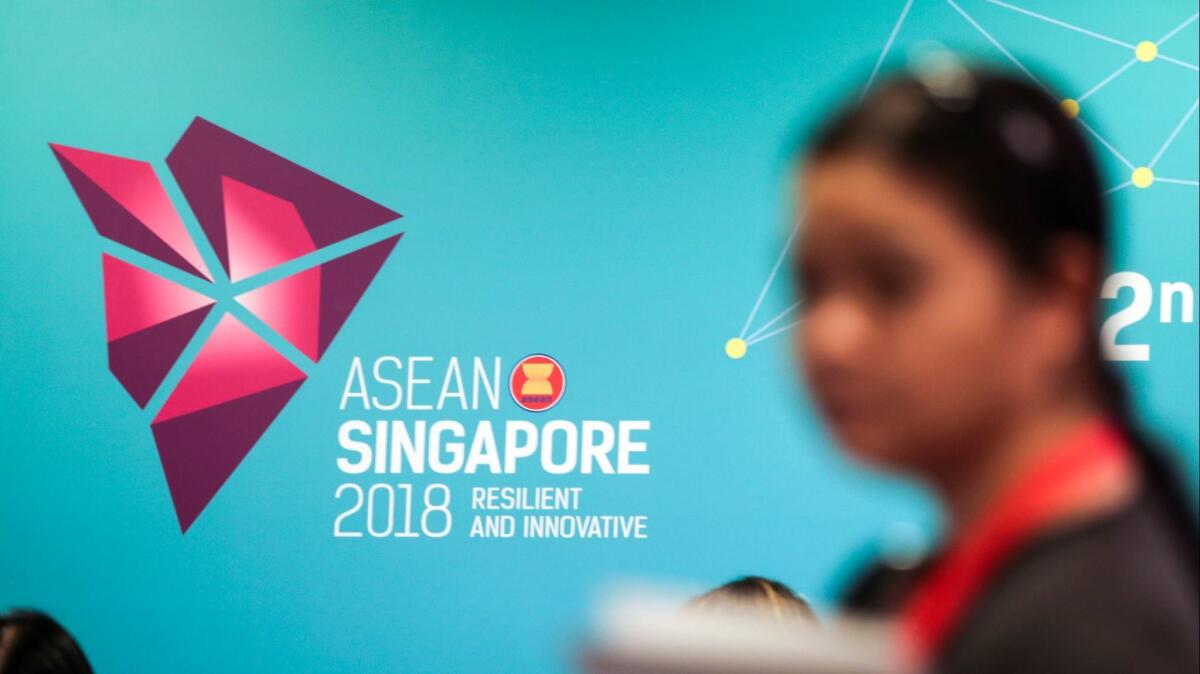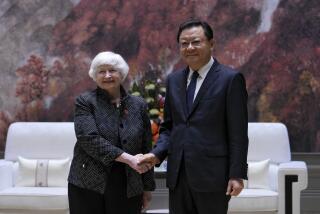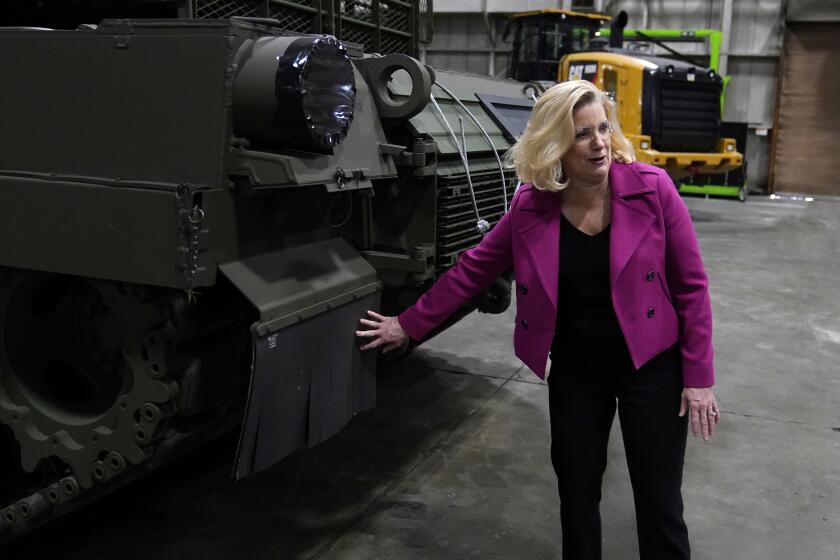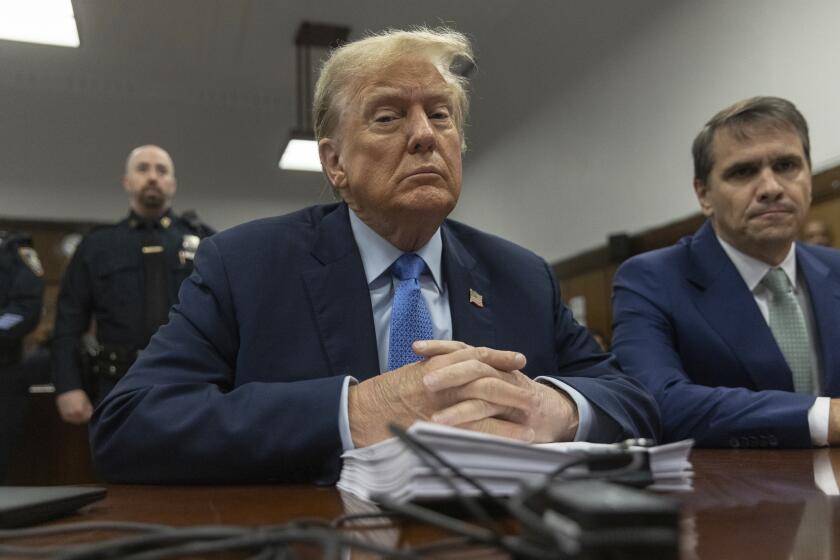Southeast Asian nations watching China-U.S. trade tiff warily, but reluctant to speak out

If China and the United States continue their charge into a full-on trade war, few regions will be as vulnerable to the resulting economic turbulence as Southeast Asia.
That’s why the 10 governments of the Assn. of Southeast Asian Nations meeting in Singapore this week are hashing out ideas about how the region can duck any shrapnel if the world’s two biggest economies keep firing protectionist salvos at each other.
“Considering that China and the U.S. are ASEAN’s first and third trading partner respectively, the early exchange of blows between Washington and Beijing would be watched nervously across all ASEAN capitals,” said Tang Siew Mun, head of the ASEAN Studies Centre at the ISEAS-Yusof Ishak Institute, a Singapore-based research organization.
Especially vulnerable is Singapore, a tiny island state sitting on the Strait of Malacca, a narrow waterway between Indonesia and Malaysia linking the Indian and Pacific oceans. One of the world’s busiest ports, Singapore’s total trade in goods and services is three times the size of country’s economy, which at around $300 billion roughly matches Connecticut’s.
Each day, hundreds of cranes hoisting thousands of shipping containers line the city-state’s extensive port facilities. Sixteen million barrels of oil and other hydrocarbons pass through the strait each day, according to the U.S. Energy Information Administration.
“As a strong proponent of free trade and supporter of the rules-based multilateral trading system, Singapore is concerned by an escalating cycle of expanding unilateral tariff measures. Such actions will have a negative impact on international supply chains and global growth,” the Singapore Trade Ministry said in a statement.
ASEAN’s members range from the Philippines, a 7,500-island archipelago that is Asia’s biggest Christian-majority country; to mostly Muslim Malaysia, a manufacturing and electronics hub; to Buddhist Myanmar, where bounteous natural resources sit strategically positioned between India and China.
Much of the region’s economy is stitched into global production chains linking usually bigger or wealthier economies in Japan, the U.S., Europe and more recently, China. Manufacturing taking place in countries such as Vietnam or the Philippines often results in parts shipped to China for final assembly before export to the U.S.
While of the region has not yet been hit by directly U.S. trade curbs, countries such as Thailand and Vietnam, which like China sell more to the U.S. than they buy, could find themselves subject to American scrutiny.
The region’s governments have spoken against protectionism and are likely to do so at this week’s summit, which ends Saturday. At the same time, however, they will be wary of saying anything that might prompt a tweet-storm from the irascible U.S. president.
“As a globally trading city-state and simultaneously ASEAN’s current chair, Singapore is likely to encourage a summit statement that cautions against trade instability without being sharply anti-Trump,” said Donald K. Emmerson, director of the Southeast Asia Program at Stanford University.
ASEAN members Brunei, Malaysia, Singapore and Vietnam have signed the revised Trans Pacific Partnership trade deal that President Trump ditched soon after taking office. All 10 ASEAN countries also are party to negotiations on the Regional Comprehensive Economic Partnership, another huge Asian free trade deal that will, if agreed, include China, Japan and India, as well as Australia, New Zealand and South Korea.
A kind of slimmed-down version of the European Union, ASEAN marked its 50th anniversary last year. Set up at the height of the Cold War, the grouping is slowly becoming more integrated, though countries typically trade more with nonmembers, such as Japan and China, than they do with one another.
But as tensions between the U.S. and China grow, ASEAN is once again caught in the middle of what could be a damaging arm-wrestle between great powers.
The latest U.S. National Security Strategy, published in late 2017, made it clear that the Trump presidency sees China as a rival to be confronted.
“We should understand that what is now happening on the trade front is an expression of a much deeper shift in Washington’s approach to China. Unlike previous Republican and Democratic administrations of the past four decades who saw China as a ‘partner’ or ‘strategic partner,’ the Trump administration has named it a ‘strategic rival’ or even ‘adversary,’” said Graham Allison of Harvard University, author of “Destined for War: Can America and China Escape Thucydides’s Trap?”
U.S.- China rivalry has caused rifts in ASEAN in the past.
In 2012, in a rare breach of ASEAN’s usually polite reserve and formal unity, a gathering of ministers ended acrimoniously as Cambodia, that year’s chair and an ally of China, refused to sign off on a statement criticizing Beijing over its activities in the South China Sea.
China claims much of the sea as its own, and its expansive claims overlap with those of Vietnam and the Philippines, a U.S. ally.
Asked if this week’s summit would feature any potentially divisive debate about the South China Sea, Phay Siphan, spokesman for the Cambodian Council of Ministers, said, “We have no idea about that; you will have to ask the ASEAN chair Singapore about the agenda.”
ASEAN countries may be reluctant to criticize China for another reason. The country’s long economic boom has been presided over by an authoritarian one-party government. Such governments are found among ASEAN members.
Cambodia’s recent crackdown on the country’s main opposition party, ahead of elections to be held at the end of July, means that Prime Minister Hun Sen will maintain control — a longevity that dates to the year after Ronald Reagan won reelection to the White House.
But Cambodia is unlikely to face any criticism from ASEAN, which includes one-party states Laos and Vietnam, as well as Thailand, a military dictatorship. A similarly muted response is likely regarding the Rohingya, a Muslim minority in western Myanmar. Last year around 700,000 Rohingya fled into Bangladesh as the Myanmar army retaliated against attacks by Rohingya militants with deadly and disproportionate force.
Leader of Myanmar Aung San Suu Kyi, a former political prisoner and Nobel laureate, has faced criticism over the Rohingya from Muslim-majority ASEAN members Indonesia and Malaysia, albeit outside the formal confines of the bloc.
Roughneen is a special correspondent.
More to Read
Start your day right
Sign up for Essential California for news, features and recommendations from the L.A. Times and beyond in your inbox six days a week.
You may occasionally receive promotional content from the Los Angeles Times.





